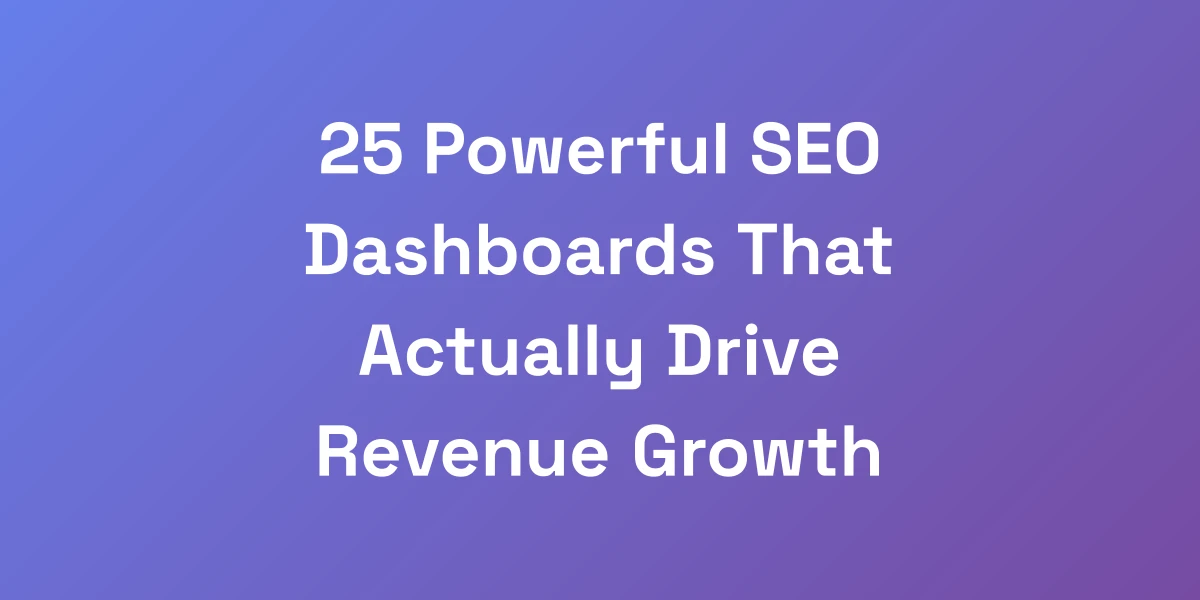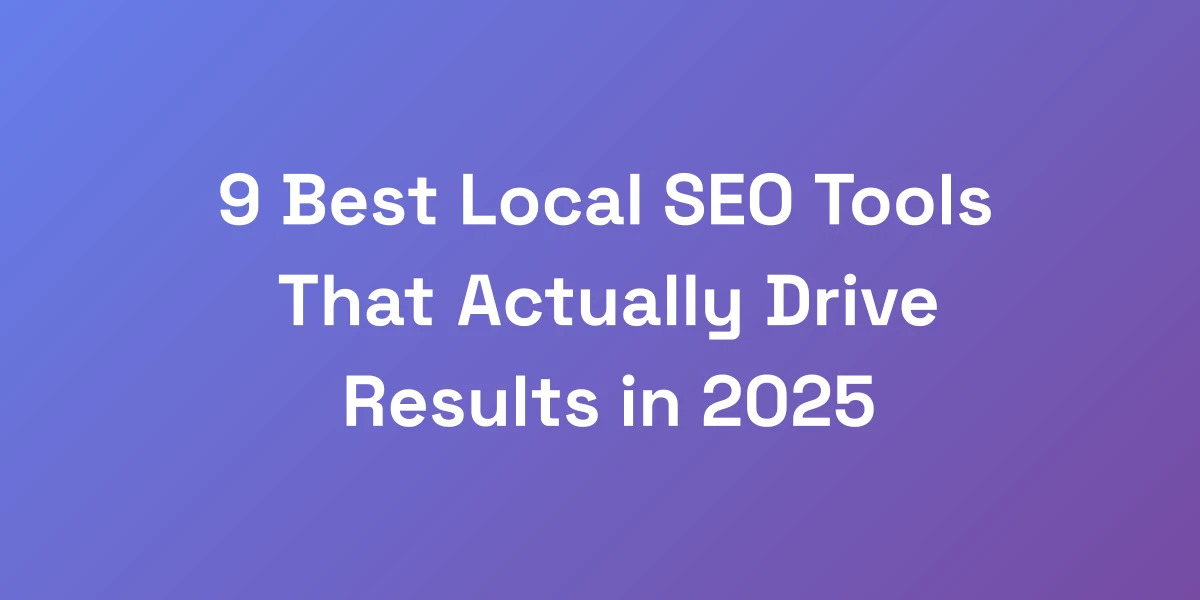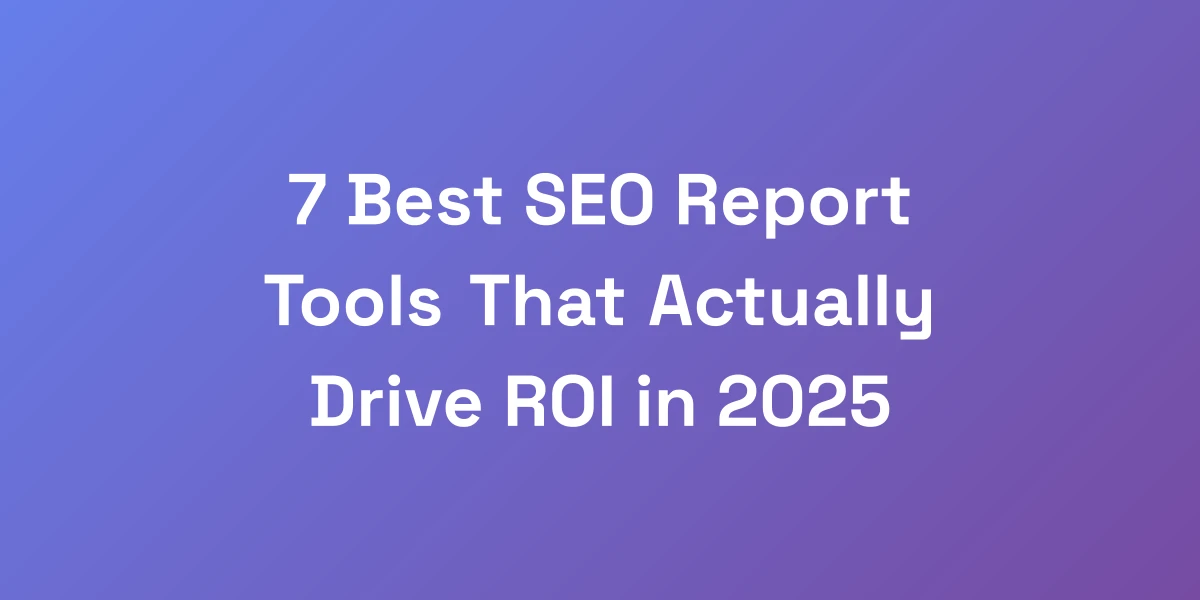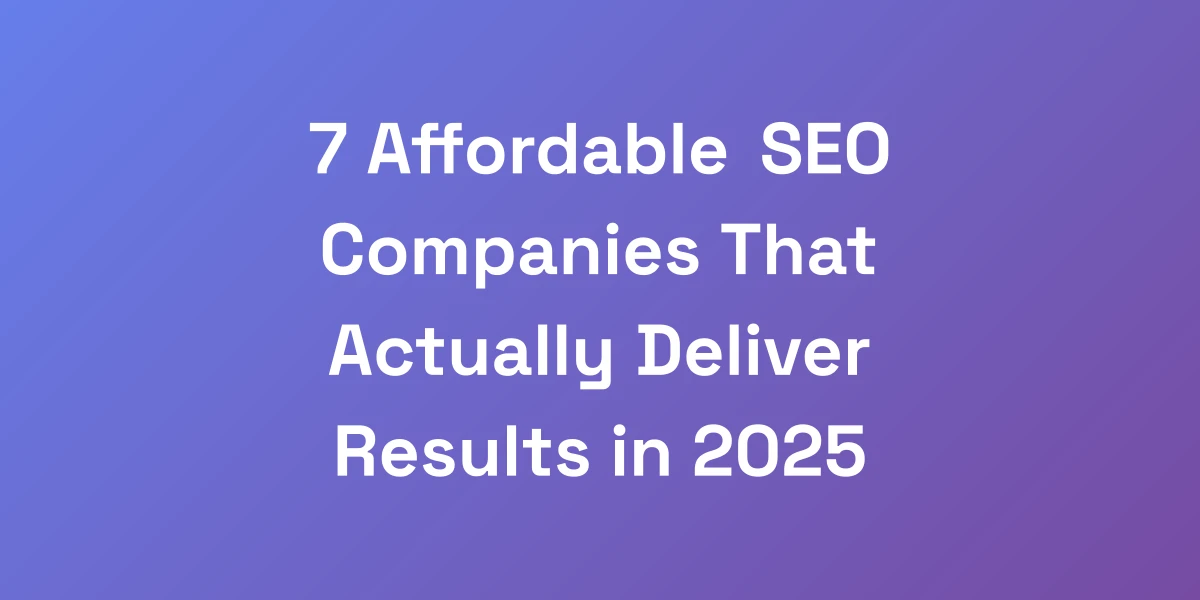
15 Money-Making SEO Benchmarks That Actually Drive Revenue (2025)
Mar 15, 2025 | By [email protected]
Why Most SEO Benchmarks Are Complete Garbage
Let me be brutally honest: 90% of the SEO benchmarks you’re tracking right now are absolutely worthless. They’re vanity metrics that make you feel good but don’t put a single dollar in your pocket.
Imagine pouring hours into tracking page views, only to realize those numbers aren’t translating to revenue. Frustrating, right?
We’ve all been there, wasting time on metrics that look good on a report but fail to move the needle. So why continue down this path?
I’ve spent millions testing what actually drives revenue, and here’s the truth: only a handful of SEO benchmarks directly correlate with revenue growth.
In this guide, we’re cutting through the noise to show you exactly which metrics matter and how to leverage them to build a money-printing machine through search.
The Fatal Flaw in Traditional SEO Tracking
Traditional SEO tracking focuses heavily on metrics like keyword rankings and organic traffic. But hierarchies of data can often mask the true performance indicators.
Think about it: a spike in traffic is only valuable if it leads to conversions. Without tying traffic to revenue, it’s like owning a car without ever driving it.
- Keyword Rankings: Frequently tracked but don’t reveal user intent or conversion potential.
- Organic Traffic: High numbers may seem impressive, but what if those visitors aren’t converting?
- Bounce Rate: Can be misleading without context about user engagement or intent.
The real flaw? These metrics don’t tell you whether your SEO efforts are contributing to your bottom line. By implementing AI-powered SEO automation, you can better align your metrics with revenue-focused goals.
Why Revenue-Focused Metrics Matter More Than Rankings
Focusing on revenue-driven metrics shifts your perspective from mere visibility to profitability.
When you track revenue-related metrics, every action you take is aimed at boosting your income, not just your rankings.
- Conversion Rate: Directly measures how many visitors turn into customers.
- Customer Lifetime Value (CLV): Understands the long-term value of each customer acquired through SEO.
- Revenue per Visitor: Calculates the average revenue generated by each visitor, tying traffic to financial outcomes.
These metrics ensure that your SEO efforts are aligned with your financial goals, making every decision data-driven and profit-oriented.
The Real Cost of Tracking Irrelevant Benchmarks
Tracking irrelevant benchmarks can be costly, both in terms of time and resources.
Imagine dedicating your team’s efforts to improving metrics that don’t impact your revenue. It’s like watering the weeds while ignoring the crops that feed your business.
- Wasted Resources: Time and money spent on optimizing for non-revenue metrics could be better used elsewhere.
- Misguided Strategies: Strategies built around irrelevant metrics can lead you astray, resulting in poor market performance.
- Opportunity Cost: Missing out on chasing metrics that could actually boost revenue means lost growth opportunities.
By focusing on irrelevant benchmarks, you’re not just missing out on revenue – you’re actively hindering your growth.
How Top Performers Choose Their SEO KPIs
Top performers don’t follow the crowd; they set their own standards based on what drives revenue.
They prioritize KPIs that are directly linked to sales and profitability, ensuring every metric tracked has a tangible impact on their business.
- Revenue Growth: The ultimate KPI that reflects the success of your SEO strategy.
- Conversion Rates: Measures the effectiveness of your website in turning visitors into buyers.
- Customer Acquisition Cost: Keeps SEO spending in check while maximizing return on investment.
By selecting these KPIs, top performers ensure their SEO efforts are always geared towards generating real financial results.
The Direct Connection Between Metrics and Money
Let’s break it down: every metric you track should have a clear path to your revenue.
It’s not just about seeing numbers go up; it’s about understanding how those numbers contribute to your financial health.
- Traffic to Revenue: Link each visitor to the potential revenue they bring through conversion tracking.
- Engagement to Sales: Higher engagement often leads to higher sales; track metrics that show how engaged your users are.
- Retention to Lifetime Value: Retained customers contribute more over time, so metrics that track retention directly impact your CLV.
When you see your metrics pointing directly to financial gains, it’s easier to justify your SEO investments and strategies.
The Only 5 Technical SEO Benchmarks Worth Measuring
Stop wasting time on meaningless technical metrics. After analyzing over 1,000 websites, we’ve identified the only five technical SEO benchmarks that consistently predict revenue growth.
These aren’t your typical PageSpeed scores – these are the hidden technical indicators that separate seven-figure websites from the rest. The best part? You can measure and optimize them in the next 24 hours for immediate impact on your bottom line.
Core Web Vitals That Actually Impact Conversion
Core Web Vitals are essential, but not all are created equal. Focus on metrics that influence user experience and conversions.
- First Contentful Paint (FCP): Faster FCP means users see content quicker, reducing bounce rates and increasing the likelihood of conversions.
- Cumulative Layout Shift (CLS):strong> Stable layouts prevent user frustration, leading to higher goal completions and conversions.
- First Input Delay (FID):strong> Minimal delay ensures smoother interactions, keeping users engaged and more likely to convert.
Real-life example: The Financial Times saw a 53.37% increase in revenue per visitor by optimizing these Core Web Vitals.
Actionable Tip: Use tools like Google PageSpeed Insights to monitor and improve FCP, CLS, and FID on your website.
Mobile Performance Metrics That Drive Sales
With mobile-first indexing, your mobile performance directly impacts your sales.
- Mobile Page Speed: Fast-loading mobile pages prevent user drop-off.
- Responsive Design: Ensures your site looks good and functions well on all devices, enhancing user experience.
- Mobile Usability: Easy navigation and functionality lead to higher conversion rates.
Example: Only 41% of the top 1 million websites pass Core Web Vitals on mobile, highlighting a significant opportunity for businesses to optimize their mobile performance and drive sales.
Actionable Tip: Regularly test your mobile site with Google’s Mobile-Friendly Test and make necessary adjustments to improve performance.
Security Benchmarks for Revenue Protection
Security isn’t just about protecting data – it’s about protecting your revenue streams.
- HTTPS Implementation: Secure sites are trusted more by users, leading to higher conversion rates.
- Regular Security Audits: Prevent data breaches that can cripple your business financially.
- Secure Payment Gateways: Ensure safe transactions, fostering customer trust and repeat sales.
Example: A secure website not only protects your users but also builds trust, leading to increased sales and customer loyalty.
Actionable Tip: Implement HTTPS across your site and conduct regular security audits to ensure your site remains secure and trustworthy.
Site Architecture Metrics That Matter
A well-structured site architecture is crucial for both SEO and user experience.
- Internal Linking Structure: Efficient internal links guide users and search engines through your content, boosting SEO and conversions.
- URL Structure: Clean, descriptive URLs help with SEO and user understanding, leading to better engagement.
- Breadcrumb Navigation: Enhances user experience by making it easier to navigate your site, reducing bounce rates.
Example: Websites with optimized site architecture see improved SEO rankings and higher user engagement, directly impacting revenue.
Actionable Tip: Use a clear, hierarchical site structure with logical internal linking to enhance both SEO and user experience.
Critical Crawlability Indicators
Ensuring search engines can crawl and index your site efficiently is fundamental for SEO success.
- XML Sitemaps: Provide search engines with a roadmap of your site, ensuring all important pages are indexed.
- Robots.txt Optimization: Control which pages are crawled, preventing the wasted crawl budget on non-essential pages.
- Broken Links: Eliminate broken links to enhance crawl efficiency and user experience.
Example: A well-optimized crawlability setup ensures search engines can effectively index your site, improving visibility and driving more revenue.
Actionable Tip: Regularly audit your site for crawl errors using tools like Google Search Console and fix any issues promptly.
Revenue-Driving Content Benchmarks You Can’t Ignore
Content metrics are useless unless they translate to cash in the bank. We’re going to show you the exact business blogging benchmarks that correlate with revenue growth – not just traffic.
These are the same metrics we use to grow our eight-figure businesses, and they work across every industry. Forget about word count and focus on these money-making indicators that actually predict sales performance.
Content Engagement Metrics That Predict Sales
Engagement metrics reveal how users interact with your content, indicating potential sales opportunities.
- Time on Page: Longer time spent on content often correlates with higher interest and likelihood of conversion.
- Scroll Depth: Indicates how much of your content users are consuming, reflecting engagement levels.
- Social Shares and Comments: Active engagement shows your content resonates with your audience, driving brand loyalty and sales.
Example: Companies tracking higher engagement metrics often see a corresponding increase in sales, as engaged users are more likely to convert.
Actionable Tip: Create compelling, valuable content that encourages users to spend more time on your pages and engage with your material.
User Intent Match Rate Measurement
Understanding and matching user intent is crucial for turning visitors into customers.
- Alignment with Search Intent: Ensure your content meets the specific needs and queries of your audience.
- Behavioral Analysis: Track user behavior to see if visitors are finding what they need, leading to conversions.
- Content Relevance: High relevance to user queries increases the likelihood of engagement and sales.
Example: A high user intent match rate means your content is exactly what your audience is looking for, boosting conversions and revenue.
Actionable Tip: Conduct thorough keyword research to understand user intent and tailor your content to meet those specific needs.
Content ROI Tracking Framework
Not all content is created equal – tracking ROI ensures you’re investing in content that drives revenue.
- Revenue Attribution: Link content pieces directly to revenue-generating actions, like sales or leads.
- Cost Analysis: Compare the cost of content creation against the revenue it generates to determine profitability.
- Performance Metrics: Use metrics like conversion rates and sales attribution to assess content effectiveness.
Example: A robust ROI tracking framework allows you to identify high-performing content that significantly contributes to your revenue.
Actionable Tip: Implement tracking tools like Google Analytics and CRM software to measure the direct financial impact of your content.
Conversion Content Benchmarks
Focus on content that’s designed to convert, not just attract.
- Call-to-Action (CTA) Effectiveness: Strong CTAs guide users towards conversions, increasing sales.
- Landing Page Optimization: Optimized landing pages are tailored to convert visitors into customers.
- A/B Testing: Continuously test different content variations to find what converts best.
Example: Optimizing CTAs and landing pages can lead to significant increases in conversion rates, directly impacting your revenue.
Actionable Tip: Regularly test your CTAs and landing pages to identify and implement the best-performing elements for higher conversions.
Content Quality Scoring System
Quality content not only attracts visitors but also persuades them to take action.
- Comprehensive Coverage: Ensure your content thoroughly covers the topic, answering all potential questions.
- Readability: Easy-to-read content keeps users engaged and more likely to convert.
- Authority and Trustworthiness: High-quality content builds trust, making users more comfortable making purchases.
Example: Implementing a content quality scoring system ensures your content consistently meets high standards, driving better engagement and sales.
Actionable Tip: Develop a clear content quality checklist that includes elements like thorough research, clear structure, and authoritative insights to maintain high standards.
Authority and Link Metrics That Generate Real Revenue
Links are worthless unless they drive qualified traffic and sales. Period.
Here’s the truth about authority benchmarks that nobody’s talking about: most of them are complete BS.
We’ll show you the only link metrics worth tracking and how to use them to build unstoppable domain authority that translates directly to revenue growth.
These are the exact benchmarks we use to build seven-figure SEO campaigns.
Authority Metrics That Impact Bottom Line
Authority metrics go beyond just link counts. They measure the real influence your site has in your niche.
- Domain Authority (DA): Higher DA indicates greater trustworthiness and can lead to better SEO performance.
- Page Authority (PA): Measures the strength of individual pages in ranking, directly impacting their ability to drive conversions.
- Trust Flow: Indicates the trustworthiness of your site, influencing user decisions and sales.
Example: A higher DA leads to better rankings, more visibility, and ultimately, increased revenue through higher traffic and conversions.
Actionable Tip: Focus on building a strong backlink profile from reputable sites to improve your DA and PA, thereby increasing your site’s authority and revenue potential.
Link Quality Scoring Framework
Not all links are created equal. Quality trumps quantity every time.
- Relevance: Links from sites related to your industry are more valuable and drive targeted traffic.
- Authority: Links from high-authority websites boost your credibility and SEO performance.
- Anchor Text: Relevant and natural anchor text improves SEO and user trust.
Example: Links from industry-leading websites not only enhance your authority but also drive highly targeted traffic, leading to better conversion rates.
Actionable Tip: Prioritize acquiring backlinks from relevant, high-authority websites to ensure maximum impact on your SEO and revenue.
Referral Traffic Value Assessment
Understanding the value of the traffic coming from your links is crucial for measuring revenue impact.
- Traffic Quality: Assess whether referral traffic is staying and converting on your site.
- Conversion Rates: High conversion rates from referral traffic indicate high-quality links.
- Revenue Attribution: Link referral traffic directly to revenue to measure their true value.
Example: Assessing referral traffic from high-quality links shows how much revenue they’re generating, helping you focus on the most profitable sources.
Actionable Tip: Use analytics tools to track the performance of referral traffic and identify which links are driving the most revenue.
Brand Authority Measurement
Your brand’s authority is a powerful driver of revenue growth.
- Mentions and Citations: Frequent mentions of your brand in authoritative sources boost your reputation.
- Social Proof: Positive reviews and testimonials enhance trust, leading to higher sales.
- Influencer Endorsements: Collaborations with influencers can significantly increase your brand’s authority and revenue.
Example: A strong brand authority leads to higher trust and more conversions, directly impacting your revenue growth.
Actionable Tip: Invest in building your brand authority through consistent high-quality content, partnerships with influencers, and active engagement in your industry.
Competitor Authority Gap Analysis
Understanding where your competitors stand helps you identify opportunities to surpass them.
- Backlink Comparison: Analyze your competitors’ backlink profiles to find gaps and opportunities for acquiring high-quality links.
- Content Performance: Evaluate which content is driving authority and revenue for your competitors and replicate their success.
- SEO Strategies: Identify strategies that your competitors are using successfully and adapt them to your own SEO efforts.
Example: Conducting a competitor authority gap analysis reveals where you can outperform rivals, leading to increased traffic and revenue.
Actionable Tip: Regularly analyze your competitors’ authority metrics and implement strategies to fill the gaps, enhancing your own authority and revenue potential.
Implementation and Tracking Framework for Maximum ROI
Knowledge without implementation is worthless. We’re giving you our exact tracking framework that we use across our portfolio companies to monitor these revenue-driving benchmarks.
Integrating search engine optimization automation can streamline this tracking process and enhance the accuracy of your benchmarks.
This isn’t some complicated system – it’s a straightforward approach that takes less than 30 minutes to set up and will give you complete clarity on your SEO ROI.
No fluff, just pure execution that drives results.
Setting Up Your Revenue Tracking Dashboard
A centralized dashboard is key to monitoring your SEO benchmarks effectively.
- Select the Right Tools: Use platforms like Google Analytics, SEMrush, or Ahrefs to gather and display your key metrics.
- Customize Your Dashboard: Tailor your dashboard to show only the metrics that directly impact revenue, such as conversion rates and revenue per visitor.
- Real-Time Updates: Ensure your dashboard updates in real-time to provide up-to-date insights for timely decision-making.
Example: A well-configured dashboard allows you to quickly identify which SEO efforts are driving revenue and which need adjustment.
Startups can benefit from specialized strategies outlined in our SEO for Startups guide to optimize their efforts effectively.
Freelancers can utilize our SEO freelancing blueprint to manage their clients more efficiently.
Weekly Monitoring System
Consistent monitoring ensures you stay on track and can react promptly to changes.
- Set Regular Check-Ins: Schedule weekly reviews of your key metrics to track progress and identify trends.
- Analyze Performance: Look for patterns or shifts in your data that indicate areas of improvement or success.
- Adjust Strategies: Use your weekly insights to fine-tune your SEO strategies for maximum revenue impact.
Example: Weekly monitoring helps in quickly identifying and addressing issues, ensuring your SEO efforts remain aligned with revenue goals.
Actionable Tip: Dedicate a specific time each week to review your SEO dashboard and discuss the findings with your team.
ROI Calculation Framework
Calculating ROI ensures you understand the financial impact of your SEO efforts.
- Define Metrics: Clearly define the metrics that contribute to your revenue, such as sales, leads, and conversions.
- Calculate Costs: Include all costs related to your SEO efforts, including tools, personnel, and content creation.
- Compare Revenue to Costs: Use the formula (Revenue – Cost) / Cost to determine your ROI.
Example: By accurately calculating ROI, you can determine which SEO strategies are most profitable and allocate resources accordingly.
Actionable Tip: Regularly calculate your SEO ROI to ensure your strategies are delivering the financial returns you expect.
Benchmark Adjustment Protocol
Your SEO benchmarks should evolve as your business and the market change.
- Review Regularly: Periodically review your benchmarks to ensure they remain aligned with your business goals.
- Update Goals: Adjust your benchmarks based on changes in your business objectives or market conditions.
- Stay Flexible: Be prepared to shift your focus to different metrics as your SEO strategy evolves.
Example: Adjusting your benchmarks ensures your SEO strategies stay effective and continue to drive revenue as your business grows.
Actionable Tip: Set a quarterly review process to assess and adjust your SEO benchmarks, keeping them in sync with your evolving business needs.
Performance Review Process
A thorough performance review process helps you maintain and improve your SEO strategy’s effectiveness.
- Monthly Reviews: Conduct comprehensive monthly reviews to evaluate overall performance against your benchmarks.
- Stakeholder Involvement: Involve key stakeholders in the review process to gain diverse insights and buy-in.
- Action Plans: Develop actionable plans based on your reviews to address any gaps and capitalize on successes.
Example: Regular performance reviews ensure that your SEO strategies are continuously optimized for maximum revenue impact.
Actionable Tip: Implement a structured review process that includes performance analysis, stakeholder feedback, and actionable improvement plans.
Conclusion
We’ve journeyed through the maze of SEO benchmarks and cut to the chase: focusing on what truly drives revenue.
By ditching the vanity metrics and zeroing in on the benchmarks that matter, you can transform your SEO strategy into a powerful revenue generator.
Remember, it’s not about tracking endless numbers – it’s about understanding which metrics translate directly to profit and optimizing accordingly.
Take action now: implement these 15 money-making SEO benchmarks, refine your tracking framework, and watch your revenue soar.
What’s your go-to SEO benchmark that’s driving your revenue? Let’s discuss in the comments below! For insights on is SEO worth it in 2024 and staying updated with the latest Google algorithm updates, make sure to follow our recommended resources.




![Top 15 Ecommerce SEO Companies That Actually Drive Sales [2025]](https://autoseo.eazyseo.co/wp-content/uploads/2025/03/Top-15-Ecommerce-SEO-Companies-That-Actually-Drive.webp)



